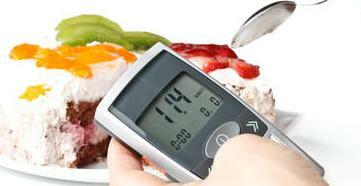 Type 2 diabetes is an endocrine disease in which there is a constant increase in glucose in the blood.
Type 2 diabetes is an endocrine disease in which there is a constant increase in glucose in the blood.
The disease is characterized by a violation of the susceptibility of cells and tissues to insulin, which is produced by pancreatic cells. This is the most common type of diabetes mellitus.
Reasons for the appearance of
Why does type 2 diabetes occur, and what is it? The disease manifests itself in insulin resistance( the absence of the body's reaction to insulin).In patients with people continues to produce insulin, but it does not interact with the cells of the body and does not accelerate the absorption of glucose from the blood.
Doctors did not determine the detailed causes of the disease, but according to current research, type 2 diabetes can be manifested by varying the volume or receptor sensitivity of cells to insulin.
Risk factors for type 2 diabetes mellitus are:
- Inadequate nutrition: the presence of refined carbohydrates in food( sweets, chocolate, sweets, wafers, pastries, etc.) and a very low content of plant food in fresh form( vegetables, fruits, cereals).
- Excess body weight, especially visceral type.
- Presence of diabetes mellitus in one or two close relatives.
- A sedentary lifestyle.
- High pressure.
- Ethnicity.
The main factors influencing the resistance of tissues to insulin include the effect of growth hormones at the time of puberty, race, sex( a greater tendency to develop the disease is observed in women), obesity.
What happens with diabetes?
After eating, blood sugar rises in the blood, and the pancreas can not produce insulin, which occurs against the background of an elevated glucose level.
As a consequence, the sensitivity of the cell membrane responsible for hormone recognition decreases. At the same time, even if the hormone penetrates the cell, there is no natural effect. This condition is called insulin resistance when the cell is resistant to insulin.
Symptoms of type 2 diabetes
 In most cases, type 2 diabetes mellitus does not have pronounced symptoms and the diagnosis can be established only with a planned laboratory test on an empty stomach.
In most cases, type 2 diabetes mellitus does not have pronounced symptoms and the diagnosis can be established only with a planned laboratory test on an empty stomach.
Typically, the development of type 2 diabetes begins in people after 40 years old, in those who are obese, high pressure and other manifestations in the body of metabolic syndromes.
Specific symptoms of are expressed in the following:
- thirst and dry mouth;
- polyuria - profuse urination;
- skin itching;
- general and muscle weakness;
- obesity;
- poor wound healing;
The patient may not suspect for a long time about his illness. He feels insignificant dryness in the mouth, thirst, itchy skin, sometimes the disease can be manifested by the appearance of pustular inflammation on the skin and mucous membranes, thrush, gum diseases, tooth loss, and vision loss. This is due to the fact that sugar, not trapped in cells, goes to the walls of the vessels or through the pores of the skin. And on sugar, bacteria and fungi multiply.
What is the danger?
The main danger of type 2 diabetes mellitus is a violation of lipid metabolism, which inevitably causes a violation of glucose metabolism. In 80% of cases against type 2 diabetes mellitus, ischemic heart disease and other diseases associated with blockage of the lumen of the vessels with atherosclerotic plaques develop.
In addition, type 2 diabetes mellitus in severe forms contributes to the development of kidney disease, reduced visual acuity, deterioration of the reparative ability of the skin, which significantly reduces the quality of life.
Stages of
Type 2 diabetes mellitus can occur with different severity options:
- The first - the patient can be improved by changing the principles of nutrition, or by using a maximum of one capsule of a sugar reducing agent per day;
- The second - improvement of the condition occurs when using two or three capsules of a sugar reducing agent per day;
- Third - in addition to the sugar reducing agents, you have to resort to the introduction of insulin.
If the patient's blood sugar level is slightly above normal, but there is no propensity to complications, then this condition is considered compensated, that is, the body can still cope with the carbohydrate metabolism disorder independently.
Diagnosis
In a healthy person, the normal level of sugar is at the level of 3.5-5.5 mmol / l. After 2 hours after eating, it is able to rise to 7-7.8 mmol / l.
For the diagnosis of diabetes mellitus, the following studies are performed:
- Blood glucose test: fasting glucose in capillary blood( blood from the finger) is determined.
- Determination of glycosylated hemoglobin: its amount is significantly increased in patients with diabetes mellitus.
- Glucose tolerance test: about 75 g of glucose dissolved in 1-1.5 glasses of water are taken on an empty stomach, then the concentration of glucose in the blood is determined after 0.5, 2 hours.
- Urinalysis for glucose and ketone bodies: the detection of ketone bodies and glucose confirms the diagnosis of diabetes.

Treatment of type 2 diabetes
When the diagnosis of type 2 diabetes has been diagnosed, treatment begins with the appointment of a diet and moderate exercise. At the initial stages of diabetes, even a slight weight loss helps normalize the carbohydrate metabolism of the body and reduce the synthesis of glucose in the liver. For the treatment of later stages, various medications are used.
Since most patients with type 2 diabetes are obese, proper nutrition should be aimed at reducing body weight and preventing late complications, especially atherosclerosis.
A hypocaloric diet is needed for all patients with an excess of body weight( BMI 25-29 kg / m2) or obese( BMI> 30 kg / m2).
Preparations
Drugs that reduce sugar are used to stimulate cells to produce additional insulin, and to achieve the desired concentration in the blood plasma. Selection of drugs is strictly by the doctor.
The most common antidiabetic drugs:
- Metformin is the drug of the first choice of hypoglycemic therapy in patients with type 2 diabetes, obesity and hyperglycaemia on an empty stomach. This tool promotes the movement and absorption of sugar in muscle tissue and does not allow to release sugar from the liver.
- Miglitol, Glucobay .These drugs inhibit the absorption of polysaccharides and oligo. As a result, the increase in blood glucose levels slows down.
- Preparations of the sulfonylurea group ( CM) of the 2nd generation( chlorpropamide, tolbutamide, glimepiride, glibenclamide, etc.) stimulate the secretion of insulin in the pancreas and reduce the resistance of peripheral tissues( liver, muscle tissue, adipose tissue) to the hormone.
- The thiazolidinone derivatives ( rosiglitazone, troglitazone) increase the activity of insulin receptors and thereby reduce the level of glucose, normalizing the lipid profile.
- Novonorm, Starlix .Affect the pancreas, in order to stimulate the production of insulin.
Drug treatment begins with monotherapy( taking 1 drug), and then becomes combined, that is, including simultaneous intake of 2 or more hypoglycemic drugs. If the above drugs lose their effectiveness, then you have to switch to the use of insulin products.
Diabetes for type 2 diabetes
Treatment of type 2 diabetes begins with a diet that is based on the following principles:
- proportional food 6 times a day. Take food should be constantly at the usual time;
- can not exceed the caloric value above 1800 kcal;
- overweight requires normalization;
- restriction of saturated fat intake;
- reduced salt intake;
- decrease in the amount of alcohol;
- food with lots of vitamins and minerals.
Products that should be excluded or, where possible, limited to :
- containing a large number of digestible carbohydrates: sweets, buns, etc.
- spicy, salted, fried, smoked and spicy dishes.
- butter, margarine, mayonnaise, cooking and meat fats.
- fatty sour cream, cream, cheese, cheese, sweet curd cheese.
- semolina, rice cereals, pasta.
- fatty and strong broths.
- sausages, sausages, sausages, salted or smoked fish, fatty sorts of poultry, fish, meat.
The dose of fiber for diabetics leaves 35-40 grams per day, and it is desirable that 51% of the dietary fiber consist of vegetables, 40% of cereals and 9% of berries, fruits, mushrooms.
Sample menu diabetic for the day:
- Breakfast - porridge oatmeal, egg. Bread. Coffee.
- Snack - natural yogurt with berries.
- Lunch - vegetable soup, chicken breast with salad( from beet, onion and olive oil) and stewed cabbage. Bread. Compote.
- Snack - low-fat cottage cheese. Tea.
- Dinner - baked in sour cream hake, vegetable salad( cucumbers, tomatoes, greens or any other of seasonal vegetables) with vegetable oil. Bread. Cocoa.
- The second supper( a few hours before sleep) is a natural yogurt, a baked apple.
These recommendations are general, since each patient should have his own approach.

Observe the simple rules of
The basic rules that a diabetic patient should take into account:
- adhere to a healthy diet
- exercise regularly
- take medicines
- check blood for a sugar level
In addition, getting rid of excess kilograms normalizes the health of people with diabetes mellitus2 types:
- blood sugar level reaches the norm
- normalizes blood pressure
- improves cholesterol level
- decreases exercise loadon the feet of the
- person feels light in the body.
Regularly measure blood sugar level yourself. When the level of sugar is known, it is possible to correct the approach to the treatment of diabetes if the sugar in the blood does not correspond to the norm.

How to choose probiotics for the intestines: a list of drugs.

Effective and inexpensive cough syrups for children and adults.

Modern non-steroidal anti-inflammatory drugs.

Review of tablets from the increased pressure of the new generation.
 Antiviral drugs are inexpensive and effective.
Antiviral drugs are inexpensive and effective.



